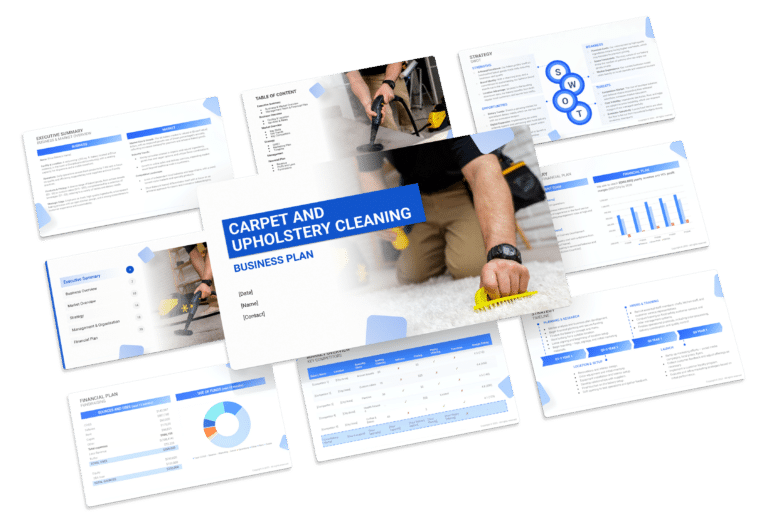Dry Cleaning Business Plan Template & PDF Example

Creating a comprehensive business plan is crucial for launching and running a successful dry cleaning business. This plan serves as your roadmap, detailing your vision, operational strategies, and financial plan. It helps establish your dry cleaning business’s identity, navigate the competitive market, and secure funding for growth.
This article not only breaks down the critical components of a dry cleaning business plan, but also provides an example of a business plan to help you craft your own.
Whether you’re an experienced entrepreneur or new to the service industry, this guide, complete with a business plan example, lays the groundwork for turning your dry cleaning concept into reality. Let’s dive in!
The Plan
Our dry cleaning business plan is structured to cover essential aspects vital for a comprehensive strategic framework. It details the business’s operational processes, marketing strategies, market analysis, competitive landscape, management team, and financial projections.
- Executive Summary: Offers an overview of your dry cleaning service concept, market analysis, management, and financial strategy.
- Business Overview: Provides detailed information on your dry cleaning service and its operational model:
- Facility & Location: Describes the facility’s layout, equipment, and the strategic importance of its location.
- Services & Prices: Lists the dry cleaning and additional services offered, such as specialized care for delicate fabrics and alterations, along with a pricing structure.
- Market Overview: Examines the dry cleaning industry landscape, identifying competitors and how your service stands out:
- Key Stats: Shares industry size, growth trends, and relevant statistics for the dry cleaning market.
- Key Trends: Highlights recent trends in the dry cleaning industry, such as online booking convenience and the shift towards eco-friendly cleaning solutions.
- Key Competitors: Analyzes main competitors in your area and differentiates your service in terms of technology, service quality, and customer care.
- Strategy: Outlines how the dry cleaning service plans to achieve growth and attract clients:
- SWOT: Strengths, weaknesses, opportunities, and threats analysis tailored to your dry cleaning business.
- Marketing Plan: Specifies marketing strategies to promote your services, including online presence, local advertising, and customer engagement initiatives.
- Timeline: Key milestones and objectives from the initial setup to the first year of operations.
- Management: Information on the management team, highlighting their background in the dry cleaning industry and areas of expertise.
- Financial Plan: Projects the 5-year financial performance of the dry cleaning service, including revenue targets, profit and loss statements, fundraising needs, cash flow projections, and balance sheet forecasts.

Executive Summary
The Executive Summary introduces your dry cleaning business plan, offering a concise overview of your dry cleaning service and its offerings. It should detail your market positioning, the range of dry cleaning and laundry services you provide, its location, size, and an outline of day-to-day operations.
This section should also explore how your dry cleaning business will integrate into the local market, including the number of direct competitors within the area, identifying who they are, along with your business’s unique selling points that differentiate it from these competitors.
Furthermore, you should include information about the management and co-founding team, detailing their roles and contributions to the business’s success. Additionally, a summary of your financial projections, including revenue and profits over the next five years, should be presented here to provide a clear picture of your dry cleaning business’s financial plan.
Dry Cleaning Business Plan Executive Summary Example

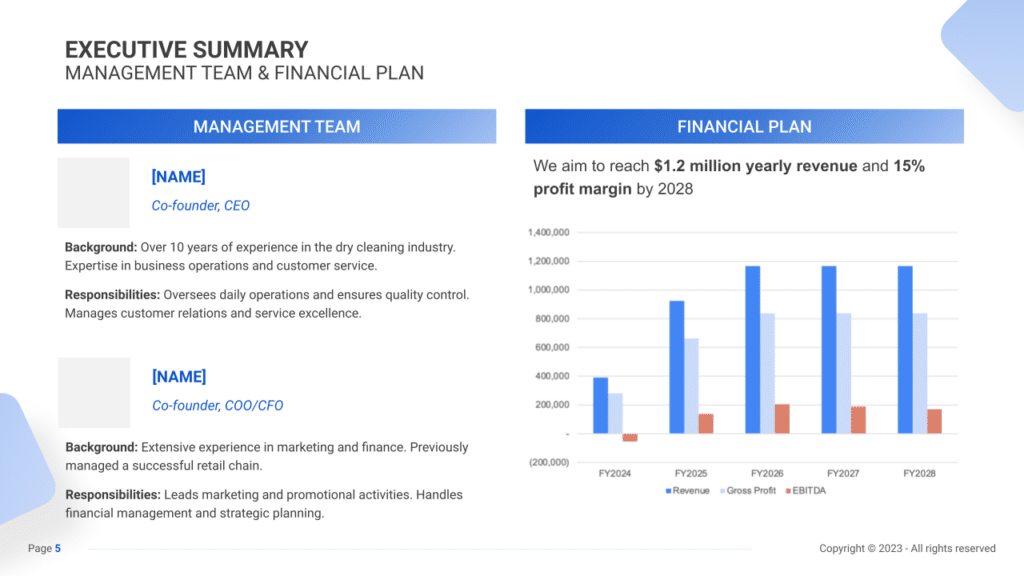
Business Overview
In the business overview section of a dry cleaning company’s executive summary, it’s essential to describe the operational aspects, location, and services offered.
This section should provide a clear understanding of what the business does, the types of services it provides, and its operational model. For a dry cleaning business, key points to highlight include the variety of cleaning services, specialized treatments for different types of garments, and any additional offerings like alterations or fabric care.
The overview should also mention the facility’s features, such as its modern equipment and customer-friendly layout, which contribute to efficient service delivery and customer satisfaction.
Example:
Clean & Shine Dry Cleaners, situated in [City/Neighborhood], offers a range of dry cleaning services, from standard garment care to specialized treatment for delicate fabrics. The facility is equipped with advanced dry cleaning technology, ensuring high-quality service. Additional services like stain removal and wedding gown preservation further broaden its appeal to customers seeking comprehensive fabric care solutions.
Market Overview
The market analysis section should evaluate the size, growth, and trends of the laundry and dry cleaning industry.
This part of the executive summary is critical for understanding the market context in which the business operates. It should assess the competitive landscape, noting the number of businesses and key competitors in the vicinity.
Trends such as the growing demand for online booking and eco-friendly cleaning methods are important to highlight, as they indicate evolving consumer preferences and potential areas for differentiation and growth.
Example:
The US laundry services and dry cleaning market, valued at $11.5 billion, is experiencing growth, driven partly by consumer trends favoring convenience and sustainability. Clean & Shine Dry Cleaners, amidst 29,000 dry cleaning businesses, stands out in its local market with seven main competitors. The company’s focus on modern cleaning technology and environmentally sustainable methods positions it well to capture the growing market segment that values these attributes.
Management Team
This section introduces the key figures leading the dry cleaning business, highlighting their backgrounds, expertise, and roles within the company.
The management team’s experience and skills are critical factors that can influence the business’s success. For a dry cleaning business, it’s important to have leaders who understand the nuances of fabric care, customer service, marketing, and financial management.
This part of the summary should build confidence in the team’s ability to manage operations effectively and grow the business.
Example:
The CEO of Clean & Shine Dry Cleaners brings over 10 years of experience in the dry cleaning industry, with a focus on quality control and customer relations. The COO/CFO, with a background in marketing and finance, leads the company’s promotional activities and financial strategy, drawing on previous experience managing a successful retail chain.
Financial Plan
The financial plan overview presents the company’s revenue and profit targets.
This section is important for outlining the financial goals and demonstrating the business’s potential for profitability and growth. It should include specific financial projections, such as yearly revenue and profit margin goals, and how these targets will be achieved through strategic planning, marketing, and operational efficiency.
Example:
Clean & Shine Dry Cleaners aims to reach $1.2 million in yearly revenue with a 15% profit margin by 2028. This financial goal is achievable through strategic expansion of services, targeted marketing campaigns, and maintaining operational excellence to maximize customer retention and attract new clients.
Business Overview
For a Dry Cleaning Business, the Business Overview section can be effectively divided into 2 main segments:
Facility & Location
Briefly describe your dry cleaning facility’s physical environment, focusing on its cleanliness, organization, and the professional atmosphere that assures customers of high-quality service.
Mention the business’s location, emphasizing its accessibility and the convenience it offers to customers, such as proximity to residential areas, office buildings, or ease of parking. Explain why this location is strategically chosen to attract your target clientele, considering factors like high foot traffic or the lack of nearby competitors.
Services & Pricing
Detail the range of dry cleaning and laundry services offered, from standard garment cleaning to specialized services such as stain removal, alterations, and pressing.
Outline your pricing strategy, ensuring it reflects the quality of services provided and is competitive within the market you’re targeting. Highlight any unique offerings, such as eco-friendly cleaning options, same-day service, or subscription models that provide added value to your customers, encouraging repeat business and customer loyalty.
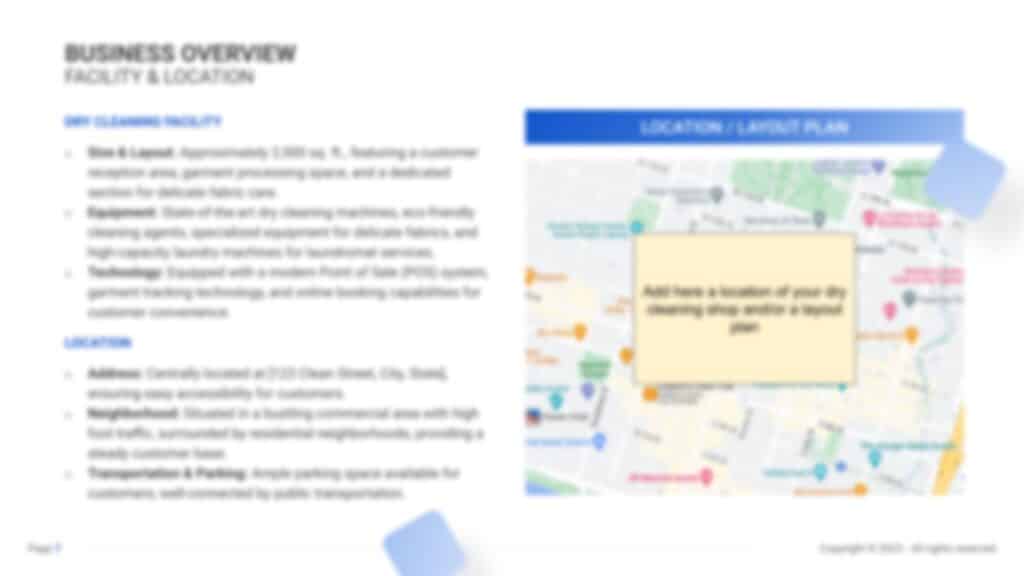
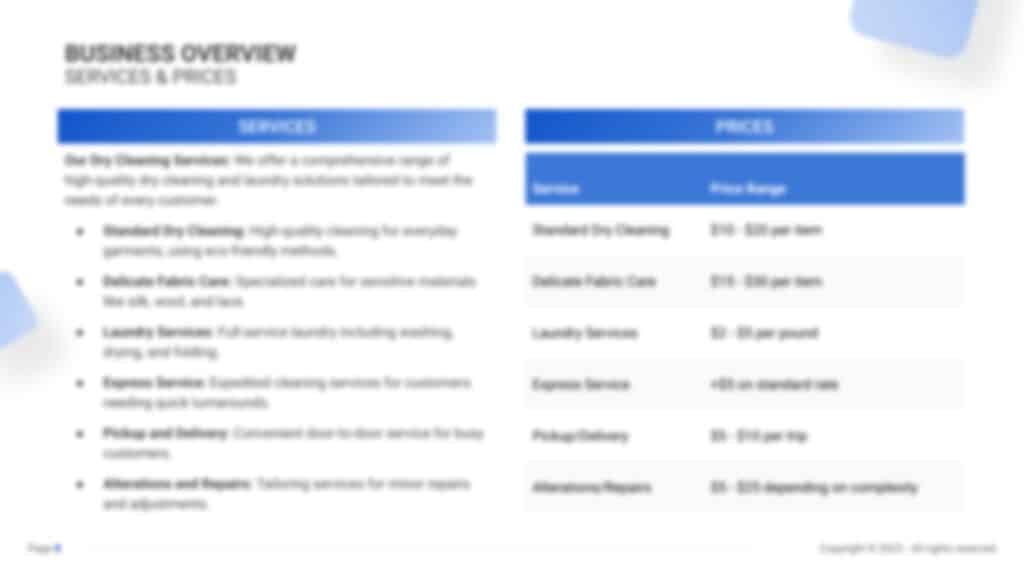
Market Overview

Industry size & growth
In the Market Overview of your dry cleaning business plan, begin by exploring the size of the dry cleaning and laundry services industry and its growth potential. This analysis is essential for grasping the market’s extent and identifying opportunities for expansion. Consider factors such as the increasing urbanization, dual-income households, and the growing demand for professional attire in the workplace as drivers for industry growth.
Key market trends
Continue by discussing recent market trends, such as the growing consumer interest in convenience services like mobile apps for dry cleaning pickup and delivery, eco-friendly cleaning methods, and the integration of technology for improved customer service and efficiency. For instance, highlight the demand for services that offer non-toxic, environmentally safe cleaning processes, and the adoption of digital platforms for easy service scheduling and tracking.
Competitive Landscape
A competitive analysis is not just a tool for gauging the position of your dry cleaning business in the market and its key competitors; it’s also a fundamental component of your business plan.
This analysis helps identify your dry cleaning business’s unique selling points, essential for differentiating your business in a competitive market.
In addition, competitive analysis is integral in laying a solid foundation for your business plan. By examining various operational aspects of your competitors, you gain valuable information that ensures your business plan is robust, informed, and tailored to succeed in the current market environment.
Identifying Competitors in the Dry Cleaning Landscape
The first phase of a comprehensive competitive analysis involves mapping out local dry cleaning services and similar businesses. Identify direct competitors like local dry cleaners, laundry services, and alterations shops. Additionally, consider indirect competitors such as laundry machines in apartment complexes or at-home dry cleaning kits that provide alternative solutions to customers.
Leverage online platforms like Google Maps, Yelp, or local business directories to gain insights into the geographical distribution of competitors and understand their customer feedback. For instance, positive reviews praising the quick turnaround time and eco-friendly practices of a competitor, “Green Cleaners,” signify an area of strength in the market that could influence customer preferences.
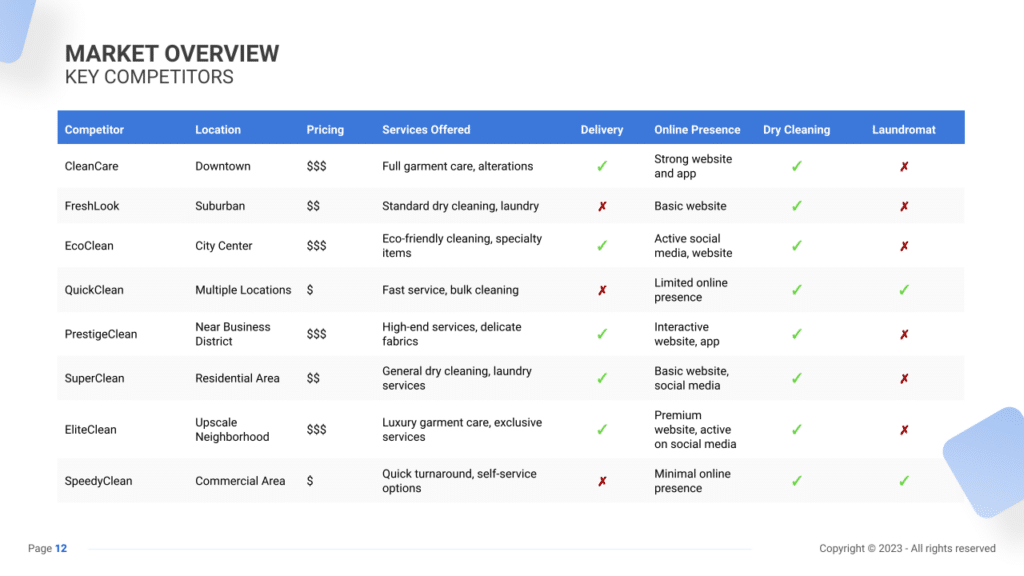
Dry Cleaning Competitors’ Strategies
Analyzing the strategies employed by competitors involves a multi-faceted approach:
- Service Offerings: Evaluate the range of services provided by competitors. If a rival business like “Express Dry Clean” is gaining traction with same-day dry cleaning and garment repairs, it signals a market trend toward convenient and efficient service.
- Quality and Technology: Assess the technology and methods used in cleaning processes. A dry cleaning service that specializes in eco-friendly, organic solvents might attract environmentally conscious customers compared to a traditional chemical-based cleaner.
- Pricing Structure: Compare pricing models among competitors. Are your service rates similar to those of budget-focused cleaners like “Value Clean,” or are they more aligned with the premium services offered by “Pristine Dry Cleaners”?
- Marketing Channels: Evaluate the marketing strategies utilized by competitors. Are they heavily reliant on digital marketing, local promotions, or partnerships with nearby businesses to attract customers?
- Customer Experience: Consider the in-store experience and customer service provided. For instance, a competitor like “Spotless Cleaning” might stand out for its personalized customer service and attention to garment detailing.
- Operational Efficiency: Observe if competitors employ automation or technology to enhance efficiency. A business like “TechClean Solutions” using an app for pickup and delivery services might cater to a different customer segment seeking convenience.
What’s Your Dry Cleaning Business’s Unique Proposition?
Define your dry cleaning business’s unique selling proposition (USP). Perhaps your service specializes in delicate fabric care, or you provide a mobile dry cleaning service catering to busy professionals.
Identify gaps in the market through customer feedback and industry trends. For instance, if there’s a growing demand for organic cleaning solutions or hypoallergenic processes in your area, this might represent an untapped opportunity.
Consider your location’s demographics: A dry cleaning service situated in a corporate district might focus on corporate accounts and express services, while one in a residential area might emphasize home pickup and delivery convenience.
Strategy

SWOT
First, conduct a SWOT analysis for your dry cleaning business, identifying Strengths (such as high-quality cleaning services and convenient location), Weaknesses (including dependency on specialized equipment or fluctuations in demand), Opportunities (for instance, the potential for implementing eco-friendly cleaning techniques or expanding services to include alterations and repairs), and Threats (such as changes in environmental regulations or the rise of on-demand laundry apps).
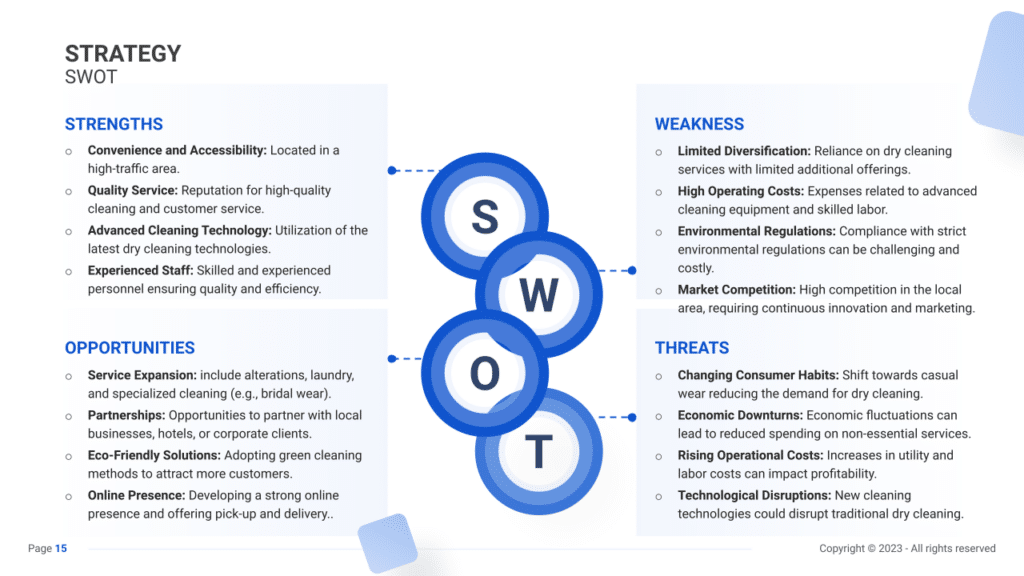
Marketing Plan
Next, develop a marketing plan that outlines strategies to attract and retain customers through various initiatives. This could include targeted advertising in local publications and online platforms, promotional offers for new customers, loyalty programs for regular clients, and a strong social media presence to engage with the community and showcase your services. Consider partnerships with local businesses or real estate agencies to broaden your customer base.
Marketing Channels
Utilize various marketing channels to effectively reach and engage potential customers.
Digital Marketing
- Website Development and SEO: Create a user-friendly website showcasing your services, pricing, and customer testimonials. Implement local SEO strategies to improve visibility in search results.
- Social Media Engagement: Expand your presence on platforms like Facebook, Instagram, Twitter, and LinkedIn. Tailor content to suit each platform; share ‘before-and-after’ transformations, highlight customer testimonials, or showcase the eco-friendly aspects of your cleaning processes. tips.
- Email Marketing Campaigns: Nurture customer relationships through regular newsletters containing valuable content such as garment care guides, seasonal promotions, customer testimonials, and exclusive offers. Personalize emails to target different customer segments based on preferences or purchase history.
Local Advertising
- Utilize local print media: Create visually appealing flyers or brochures highlighting your services, special offers, and contact information. Place advertisements in local newspapers or community magazines to reach a wider audience. Collaborate with local businesses such as boutiques or tailors to feature cross-promotional offers.
- Engage in Community Events: Participate in local fairs, street markets, or community events. Set up a booth showcasing your cleaning processes or offer quick garment evaluations to demonstrate your expertise. Sponsor local events or sports teams to increase brand visibility.
Promotional Activities
- Introduce Seasonal Promotions: Create seasonal offers tied to specific occasions or times of the year. For example, ‘Spring Wardrobe Refresh’ promotions offer discounts for cleaning multiple items or ‘Back-to-School’ specials with discounted rates for school uniforms.
- First-Time Customer Offers: Provide exclusive discounts or a complimentary service for first-time customers to encourage them to experience your high-quality cleaning services.
- Implement Reward Systems: Develop loyalty programs where customers earn points for every garment cleaned, which can later be redeemed for discounts, free services, or special gifts. Offer incentives for referrals to encourage existing customers to bring in new business.
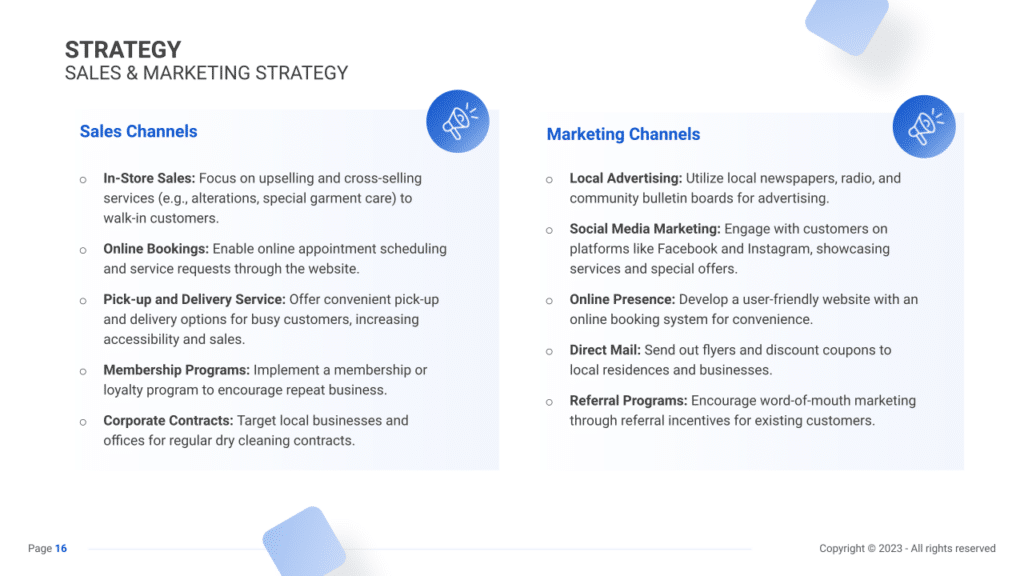
Sales Channels
Optimize sales channels to enhance the customer experience and maximize revenue for your dry cleaning business.
In-store Upselling
- Empower Staff for Upselling: Train your staff to understand the range of services offered and to suggest relevant additional services or treatments. For example, when a customer drops off a suit for dry cleaning, staff can recommend stain protection treatment or alterations if needed.
- Visual Merchandising: Strategically display add-on services or products at the counter or checkout area. This can include garment care kits, stain removal pens, or fabric fresheners, encouraging impulse purchases.
Online Booking and Sales
- Streamline Online Booking: Invest in an efficient and user-friendly online booking system integrated into your website and social media platforms. Ensure it allows for easy selection of services, scheduling, and payment processing, making it convenient for customers to use.
- E-commerce Integration: Extend your online platform to include an e-commerce section where customers can purchase specialty garment care products, such as eco-friendly detergents or stain removers. Provide detailed product descriptions and emphasize their benefits.
Subscription and Membership
- Tailor Subscription Plans: Offer tiered subscription plans for regular customers, providing different levels of service frequency or additional perks based on their needs. These could include monthly plans for office wear or bi-weekly plans for families.
- Exclusive Membership Benefits: Consider developing a premium membership tier offering priority services, free pickup and delivery, or access to member-only promotions and events. Highlight the value of membership and the benefits of long-term commitment.
Strategy Timeline
Finally, create a detailed timeline that maps out key milestones for the dry cleaning business’s launch, marketing campaigns, customer growth, and potential service expansion. This timeline should provide a clear path for the business’s development, including short-term goals for establishing the brand in the local market and long-term objectives for growth and diversification of services.

Management
The Management section focuses on the dry cleaning business’s management and their direct roles in daily operations and strategic direction. This part is crucial for understanding who is responsible for making key decisions and driving the dry cleaning towards its financial and operational goals.
For your dry cleaning business plan, list the core team members, their specific responsibilities, and how their expertise supports the business.


Financial Plan
The Financial Plan section is a comprehensive analysis of your financial projections for revenue, expenses, and profitability. It lays out your dry cleaning business’s approach to securing funding, managing cash flow, and achieving breakeven.
This section typically includes detailed forecasts for the first 5 years of operation, highlighting expected revenue, operating costs and capital expenditures.
For your dry cleaning business plan, provide a snapshot of your financial statement (profit and loss, balance sheet, cash flow statement), as well as your key assumptions (e.g. number of customers and prices, expenses, etc.).
Make sure to cover here
_ Profit and Loss
_ Cash Flow Statement
_ Balance Sheet
_ Use of Funds






